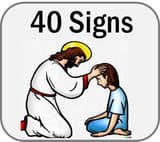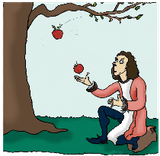Pro: 40 Signs
Back to listing
During his brief, three years of public life, Jesus and his followers performed more than 40 wondrous “signs,” often referred to as “miracles”. These signs included curing blindness and various diseases, exerting control over the weather, multiplying food that fed thousands, transforming water into wine, and even restoring bodily life to the dead. Although many of these events are primarily recorded by authors of the New Testament Bible, even some non-Biblical authors of that general era also reference them.
What might have been Jesus’s motivation in performing these spectacular feats? These miracles served as compelling evidence, validating his divine mission as the prophesized Messiah foretold in the Old Testament Bible. The Jewish concept of the Messiah portrays Jesus as the savior of the Jewish people. When the Jewish leaders asked Jesus, “How long will you keep us in suspense? If you are the Christ, tell us plainly.” Jesus answered them, “I told you, and you do not believe. The works that I do in my father’s name, they bear witness to me” (John 10:25).

If one acknowledges the existence of God as the Creator of the universe, and accepts Jesus as truly the co-equal “Son of God,” the question of “how” Jesus might possess such power to perform miracles becomes self-evident. Compared to initiating the “Big Bang” (the creation of our universe), miraculously curing blindness would seem to be a relatively trivial task. The more profound question might then be, could these feats have been: 1.) Staged like a Penn and Teller magic show in Las Vegas? 2.) Simply a myth or big lie? or, just maybe 3.) Perhaps these miracles actually did occur?
Background
Roughly 2,000 years ago, the miracles that Jesus and his followers are deemed to have performed, provided vital evidence of his divine nature. This is well-documented in the 27 writings from nine authors in the New Testament. These miracles were chronicled within an historically brief period of time, shortly following the events they describe. Indeed, Jesus’s miracles were a foundational component of the early Christian church. However, around the 19th century, the emergence of scientific progress appeared to drive Biblical miracles into obscurity. In his book Miracles and Supernatural Religion, theologian James Whiton stated that there was an “evaporation of the former evidential value of miracles. . . . The transfer of miracles from the artillery to the baggage of the Church.” During the 21st century, some pastors have even avoided the mention of miracles as a fundamental component of Christian faith. In fact, Thomas Jefferson, a deist, was a harbinger of this trend. Around 1820, at the age of 77, the third president of the United States edited his own personal Bible, removing all references to miracles, including Jesus’s Resurrection, rejecting God’s intervention in this world thru miracles.
Despite this trend, many signs Jesus performed are supported by substantial evidence. His miracles were not only witnessed by his followers, but also thousands of people in many cities and rural areas of what is now Israel, Jordan, the Golan Heights, and Syria. Many beneficiaries of these miracles lived long after Jesus departed this earth, serving as firsthand witnesses to these events. Over 80 separate references to these miracles can be found in the four biblical Gospels. The person of Jesus, as well as reports of some of his supernatural occurrences, were also noted in the early non-Christian writings of Josephus (37–101 A.D.), Thallus (52 A.D.), Tacitus (56–120 A.D.), Mara Bar-Serapion (70 A.D.), Phlegon (80–140A.D.), Pliny the Younger (61–-113 A.D.), Lucian of Samosata (115–200 A.D.), as well as the later Jewish Talmud and the Islamic Koran. Jesus’s disciples were so persuaded by his teachings and powerful signs, especially his Resurrection, that all of his apostles endured great suffering for their belief, with all but John laying down their lives as martyrs.

The list below details some of the characteristics of miracles witnessed by thousands of people during Jesus’s short, three-year ministry. According to Dr. William Lane Craig, a philosopher and Christian advocate, these miracles can reasonably be explained by the following logic: "Catching the apple doesn't overturn the law of gravity or the formulation of a new law. It's merely an intervention of a person with free will who overrides the natural causes operative in that particular circumstance. And that is, essentially, what God does when he causes a miracle to occur."
Miracles Common Characteristics: Reasons Why Jesus’s Miracles Might Be True?
- Number of Signs: Jesus is credited with performing 35 specific miracles, with many references to additional miracles he did as well as those of his followers.
- Multiple Sources: 25 specific signs were corroborated in at least two or more Gospel writings.
- Diversity of Miracles: The recorded miracles range from curing maladies as simple as a fever, to bringing people back to life or controlling the weather. Over 20 different types of such events are recorded.
- Variety of Locations: Miracles were conducted in more than 25 different locations, making the possibility of deception much more difficult.
- Swift Results: Miracle results were quick (seconds or minutes), reducing the probability of random chance or fraud.
- Incurable Diseases: Many of the diseases or maladies were incurable at the time.
- No Props: Jesus did not us any “props.” No surgical robots, drugs, X-ray machines, or magic hats.
- Public Display: Most miracles were performed in public locations with various witnesses, and often by large crowds.
- Documentation Details: Many miracle accounts are specifically documented in the New Testament with the following level of detail: 1.) The miracle’s description; 2.) City, location, environment; 3.) Time of day; 4.) Recipient; and 5.) Witnesses. If these “miracles” were myths, such an extensive level of detail would be highly unusual.
- Writer Authority: Gospel writers that documented the miracles were either firsthand witnesses or reported by close companions of those who witnessed these events.
- Writing Timeliness: Most New Testament documents were initially written within about 20–60 years of the actual events, reducing the likelihood of inaccuracies or exaggeration that are more likely to occur over a longer period of time.
Summary
Christians believe that if God possesses the power to create our universe from nothing, it follows that He could also easily perform miracles such as those of the Messiah. These events are backed up by substantial historical evidence, along with in-depth logical analysis, to the extent that even 21st-century Nobel-Prize-winning scientists have accepted Jesus’s miracles as an integral part of their Christian faith. We invite you to delve further into this fascinating topic, as you too may be swayed by the evidence and rational support for the signs performed by Jesus of Nazareth.
Please feel free to explore the provided links to videos, documents, quotes, and books for a more in-depth study of Jesus and the miraculous signs he performed. If you haven’t already, please consider making the Christian Decision and discovering your role in the Christian story.
There's so much more!
You're asking the right questions, and now you want to dig a little deeper.
